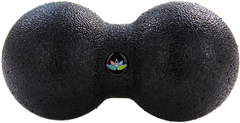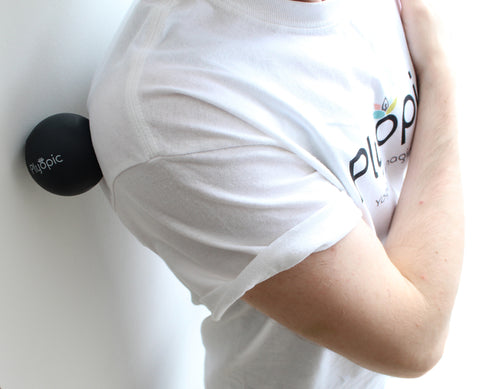Back to index
1. Neck, Shoulders & Upper Back
It is estimated that around 10% of people at any point in time suffer from chronic neck or shoulder pain. This figure is predicted to increase as computer work, cell phones, and the myriad of other gadgets we now use force us to crane our necks forward more each day than ever before.
Our bodies just aren’t designed to be sedentary for more than half an hour at a time.
Massaging the neck regularly goes a long way in reducing pain, stiffness and limited mobility. It’s difficult to do on your own and that’s why Plyopic Deep Tissue Massage Balls are such a great tool to have in your home or office to prevent and treat muscle pulls any time, or as soon as you notice them coming on.
1.1 Neck & Upper Back (Upper Trapezius)

Upper Trapezius Muscle Anatomy
(Trigger Point 2)

Upper Trapezius Muscle Application
Up Against Wall
(Trigger Points 1 & 2)

Upper Trapezius Muscle Application
Up Against Corner of Wall
(Trigger Point 2)
Upper Trapezius Muscle Application
On Floor
(Trigger Point 2)

Upper Trapezius Muscle Application
On Floor with Bolster
Your trapezius muscles are some of the first to bother you when you are under stress. They ache and burn from the base of your skull to between your shoulder blades. The good news is that they are relatively easy to massage.
Upper Trapezius tension commonly causes neck pain and headaches. Use of a massage ball in this area can be effective in reducing muscular tension caused by computer use.
Self application of massage using massage balls for the upper trapezius is possible using a wall for lighter pressure or the floor for increased pressure. It will help with your entire back or neck. Roll the ball with your body, applying as much pressure as is comfortable.
|
Anatomy and Function:
|
- The trapezius is a broad triangular muscle which attaches to the base of the skull, and lies at the back of the neck, over the upper shoulders and extends down your upper back to your mid back. It is one of the most likely muscles to get sore knots or “trigger points”.
- The upper trapezius fibers span from the top of the upper back to the base of the skull, and act on the scapula and cervical spine, with their biggest role as the prime mover in scapular elevation.
|
|
Reasons to Treat:
|
- Trap pain is classic stress pain. Your shoulders ache, your neck hurts and it is often deep and achy. You may have a headache, especially in the temples or behind your eyes or at the base of your skull. You may feel burning between your shoulder blades after sitting at your computer without elbow support.
Common symptoms:
- Headaches on the temples / "tension" headaches
- Facial, temple, or jaw pain
- Pain behind the eye
- Dizziness or vertigo (in conjunction with the sternocleidomastoid muscle)
- Severe neck pain
- A stiff neck
- Limited range-of-motion
- Intolerance to weight on your shoulders
|
|
Massage Balls to Use:
|
 
|
|
Set-up:
|
Wall
- Stand next to a wall and place a massage ball on the wall at Trigger Point 2 position
Door Frame or Corner of Wall
- Stand in a bent forward position with your shoulder rested against a door frame or corner of a wall. Place a massage ball between the door frame or wall and Trigger Point 1 (TP 1) position
Floor
-
Simply lie on the ground and place the peanut massage ball or the single massage ball behind your neck, just to the right / left of your spine and below your skull. Sink in to the massage ball and roll your head slightly to the left and right, avoiding your bony bits. Use a book as a bolster if required to provide elevation in the small of the neck
- Lie on a mat or the floor and place a massage ball directly below the base of the neck or Trigger Point 2 position.
|
|
Actions:
|
- Roll the massage ball up and down the length of your neck or the areas around TP 1 or TP 2 for 30-60 seconds, controlling the location and pressure by moving your body. If you find a tight spot, stop and hold your position for 30 seconds before continuing. Switch sides after a minute or two
|
1.2 Shoulders
1.2.1 Posterior Shoulder Capsule

Posterior Shoulder Capsule Muscle Anatomy
|
Anatomy and Function:
|
- The posterior shoulder capsule encloses the back portion of the shoulder joint.
- The shoulder capsule provides passive stability to the shoulder joint and helps lubricate the joint by secreting synovial fluid.
|
|
Reasons to Treat:
|
- The posterior capsule is often scarred/adhered in overhead throwing athletes.
- A tight/stiff posterior capsule can lead to a loss in internal rotation.
|
|
Massage Balls to Use:
|

|
|
Set-up:
|
- Stand next to a wall and place a massage ball on the wall at shoulder height.
- Push the posterior portion of your shoulder into the ball to hold it in place.
|
|
Actions:
|
- With the massage ball pinned between your shoulder and the wall, roll it back and forth. It may help to work in small sections as the massage ball doesn’t have a large circumference.
- Roll for 30-60 seconds, and then switch sides.
- To increase the intensity, pull your arm across your body using your opposite arm. You can also extend the shoulder and flex the elbow to gain a deeper stretch.
|

Posterior Shoulder Capsule Muscle Massage
1.2.2 Infraspinatus and Teres Minor
You might not always notice sore spots surrounding your shoulders in your upper back, but chances are you have them. The shoulder joint is incredibly complex and lots of muscles originate and insert around the joint. The tricky part is finding tightness without placing too much pressure on the flat, triangle-shaped bone of the scapula.

Infraspinatus and Teres Minor Muscles Anatomy

Infraspinatus and Teres Minor Muscles Massage
Starting Position

Infraspinatus and Teres Minor Muscles Massage
Position 2

Infraspinatus and Teres Minor Muscles Massage
Position 3
|
Anatomy and Function:
|
- The infraspinatus and teres minor run from the medial border of the scapula to the back of the humerus.
- The infraspinatus and teres minor are external rotators of the shoulder, and they are also responsible for decelerating internal rotation. They are two of the four rotator cuff muscles.
|
|
Reasons to Treat:
|
- There are often trigger points and adhesions in the infraspinatus/teres minor which can decrease strength and restrict movement quality.
- Rotator cuff health is integral for many athletes, especially those participating in overhead throwing sports (e.g. baseball, volleyball and tennis).
|
|
Massage Balls to Use:
|

|
|
Set-up:
|
- Lie on your back with a massage ball pinned between your shoulder blade and the floor.
- The upper arm should lie flat on the floor, with your lower arm at a 90 degree angle to it.
|
|
Actions:
|
- Start by manually massaging under your armpit, behind your shoulder and across and around your scapula. When you find areas of tightness, lie back on the massage ball and let gravity do the work, moving the massage ball as needed to target new areas.
- Slowly internally and externally rotate your shoulder (move your hand back and forth while keeping the elbow in place).
- Repeat for 8-10 passes, and then switch arms
- Try to focus on specific areas of tightness as you find them, rolling the ball in a few different directions.
|
Back to index














